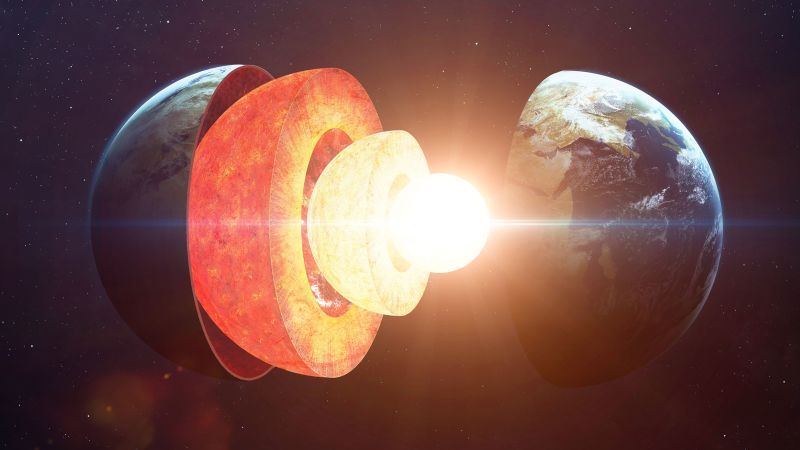**Understanding Earth’s Inner Core: Revelations from Recent Research**
Scientists have made a fascinating breakthrough regarding the innermost layer of our planet, confirming changes not only in the rotation of Earth’s inner core but also in its shape. This revelation comes shortly after researchers reported that the solid inner core reversed its spin relative to the rest of Earth. The new study, published in the journal *Nature Geoscience*, suggests that the inner core has experienced deformation over the past two decades, marking significant progress in our understanding of this enigmatic layer beneath our feet.
Earth’s inner core is a massive, solid sphere composed primarily of iron and nickel, reaching temperatures up to 9,800 degrees Fahrenheit (5,400 degrees Celsius). It is approximately 70% the size of our Moon, boasting a radius of about 759 miles (1,221 kilometers). Surrounding it is a liquid metal outer core that plays a crucial role in generating Earth’s magnetic field. For decades, scientists have theorized that as the inner core spins, it experiences deformation. Now, seismic data has provided the first tangible evidence of this phenomenon.
By analyzing earthquake data collected between 1991 and 2023, a research team has discovered variations in the inner core’s shape, influenced by seismic waves generated by powerful earthquakes. These waves serve as indicators, revealing changes to the interior structure of the inner core. The team found that while the inner core once rotated in sync with Earth’s rotation, around the year 2010, it began to slow down and now revolves in the opposite direction.
Dr. John Vidale, a professor of Earth Sciences at the University of Southern California and a co-author of the study, emphasized the significance of these findings. The research lay the groundwork for making sense of variations in seismic wave heights, which point to alterations in the inner core’s surface. This interplay between the inner and outer core not only enhances our understanding of geodynamics but holds potential implications for the forces at work that sustain the magnetosphere, the shield that protects Earth from solar radiation.
Dr. Yoshi Miyazaki, an associate professor at Rutgers University, highlights that such studies foster a deeper understanding of the dynamics governing the inner core. While prior research has addressed changes in the rotation of the inner core, this newly published study introduces a novel perspective by investigating non-rotational changes, thus enriching the discourse surrounding this complex geological phenomenon.
Despite the inherent challenges of directly observing the inner core due to its inaccessibility, scientists employ seismic analysis to glean insights into its structure. Earthquakes generate two main types of seismic waves—P waves, which travel through the core, and S waves, which do not penetrate it. The research revealed amplitude changes in a particular type of wave known as PKIKP, indicative of modifications in the inner core’s shallower levels.
The team’s analysis drew from 168 pairs of seismic waves originating from 42 earthquake locations near the South Sandwich Islands in the South Atlantic. By tracking the speed and direction of the inner core’s rotation, the researchers determined changes in its shape. This enables a comparison of seismic waves as they interacted with the core at different times, allowing for precise assessments of deformations independent of the core’s rotation.
The study raises intriguing questions about the nature of the inner core’s deformation, speculating that features like ‘topography changes’ or ‘sliding movements’ similar to landslides may be at play. Continued investigations may yield further insights into the dynamic processes shaping the solid inner core.
Current theories suggest that as Earth’s solid inner core spins, the molten outer core continues to churn and shape the magnetic energy enveloping our planet. However, the outer core is gradually cooling and shrinking, indicating a long-term transformation of Earth’s core structure that will ultimately lead to the solidification of the entire core. Dr. Vidale notes that this eventual development may extinguish Earth’s magnetic field, projecting an uncertain future for life as it exists today.
Despite being billions of years in the future, the possibility of a magnetosphere devoid of fluid motion within the core poses significant implications for Earth’s long-term evolution. While the immediate effects on life due to changes at the inner-outer core boundary may not be apparent, their correlation has substantial importance for understanding our planet’s geological and magnetic dynamics.
As research continues to unfold, we can expect to unlock further mysteries surrounding Earth’s inner core and the essential processes that contribute to our planet’s magnetic and geological identity. Understanding these deep-seated phenomena will not only enhance our appreciation of Earth as a living entity but may also inform us about the future trajectory of our planet in the vast cosmos.
Mindy Weisberger, an accomplished science writer, encapsulates the highlights of these proceedings, emphasizing the pivotal role that ongoing research plays in unraveling the complexities of Earth’s internal structures.












